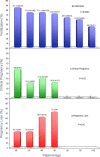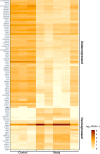Genetic and epigenetic profiling of the infertile male
- PMID: 30897172
- PMCID: PMC6428317
- DOI: 10.1371/journal.pone.0214275
Genetic and epigenetic profiling of the infertile male
Abstract
Evaluation of reproductive quality of spermatozoa by standard semen analysis is often inadequate to predict ART outcome. Men may be prone to meiotic error and have higher proportion of spermatozoa with fragmented chromatin, capable of affecting the conceptus' health. In men with unexplained infertility, supplementary tests may be pivotal to gain insight into the paternal contribution to the zygotic genome. A total of 113 consenting men were included in the study, with an additional 5 donor specimens used as control. Among study participants, 87 were screened for sperm aneuploidy by fluorescent in situ hybridization (FISH) and ranked according to their increasing age. A total of 18 men were assessed by whole exome sequencing and categorized according to their reproductive outcome as either fertile or infertile. Another set of men (n = 13) had their gene expression analyzed by RNA-seq and were profiled according to their reproductive capacity. FISH revealed that the average aneuploidy rate was highest for men over-55 age group (9.6%), while men >55 had the highest average disomy for chromosomes 17(1.2%) and 18(1.3%). ART results for the entire cohort comprised 157 cycles, stratified by paternal age. The youngest age group (25-30 years) had a fertilization rate of 87.7% which decreased to 46.0% in the >55 age group. Clinical pregnancy rate was highest in the 25-30yr group (80.0%) while no pregnancies were attained in the >55 age groups. Pregnancy loss was characterized by a steadily increasing trend, highest in the 51-55 age group (50.0%). NGS was performed on a cohort of patients classified as having recurrent pregnancy loss. This cohort was classified as the infertile group (n = 10) and was compared to a control group (n = 8) consisting of patients successfully treated by ART. Eight couples in 17 ICSI cycles achieved a clinical pregnancy rate of 82.4% while 10 infertile couples treated in 21 cycles achieved a pregnancy rate of 23.8%, all resulting in pregnancy loss. DNA-sequencing on spermatozoa from these patients yielded overall aneuploidy of 4.0% for fertile and 8.6% for the infertile group (P<0.00001). In the infertile cohort, we identified 17 genes with the highest mutation rate, engaged in key roles of gametogenesis, fertilization and embryo development. RNA-seq was performed on patients (n = 13) with normal semen analyses. Five men unable to attain a pregnancy after ART were categorized as the infertile group, while 8 men who successfully sustained a pregnancy were established as the fertile control. Analysis resulted in 86 differentially expressed genes (P<0.001). Of them, 24 genes were overexpressed and 62 were under-expressed in the infertile cohort. DNA repair genes (APLF, CYB5R4, ERCC4 and TNRFSF21) and apoptosis-modulating genes (MORC1, PIWIL1 and ZFAND6) were remarkably under-expressed (P<0.001). Sperm aneuploidy assessment supported by information on gene mutations may indicate subtle dysfunctions of the spermatozoon. Furthermore, by querying noncoding RNA we may gather knowledge on embryo developmental competence of spermatozoa, providing crucial information on the etiology of unexplained infertility of the infertile male.
Conflict of interest statement
The authors have declared that no competing interests exist.
Figures











Similar articles
-
Profiling the male germline genome to unravel its reproductive potential.Fertil Steril. 2023 Feb;119(2):196-206. doi: 10.1016/j.fertnstert.2022.11.006. Epub 2022 Nov 12. Fertil Steril. 2023. PMID: 36379263 Free PMC article.
-
Revisiting aneuploidy profile of surgically retrieved spermatozoa by whole exome sequencing molecular karyotype.PLoS One. 2019 Jan 4;14(1):e0210079. doi: 10.1371/journal.pone.0210079. eCollection 2019. PLoS One. 2019. PMID: 30608972 Free PMC article.
-
Patients with multiple morphological abnormalities of the sperm flagella due to DNAH1 mutations have a good prognosis following intracytoplasmic sperm injection.Hum Reprod. 2016 Jun;31(6):1164-72. doi: 10.1093/humrep/dew083. Epub 2016 Apr 19. Hum Reprod. 2016. PMID: 27094479
-
Sperm chromosomal abnormalities and their contribution to human embryo aneuploidy.Biol Reprod. 2019 Dec 24;101(6):1091-1101. doi: 10.1093/biolre/ioz125. Biol Reprod. 2019. PMID: 31318411 Review.
-
Relationship between degree of methylation of sperm long interspersed nuclear element-1 (LINE-1) gene and alteration of sperm parameters and age: a meta-regression analysis.J Assist Reprod Genet. 2024 Jan;41(1):87-97. doi: 10.1007/s10815-023-02980-z. Epub 2023 Nov 3. J Assist Reprod Genet. 2024. PMID: 37921972 Free PMC article. Review.
Cited by
-
Histone Chaperones as Cardinal Players in Development.Front Cell Dev Biol. 2022 Apr 4;10:767773. doi: 10.3389/fcell.2022.767773. eCollection 2022. Front Cell Dev Biol. 2022. PMID: 35445016 Free PMC article. Review.
-
MORC protein family-related signature within human disease and cancer.Cell Death Dis. 2021 Nov 27;12(12):1112. doi: 10.1038/s41419-021-04393-1. Cell Death Dis. 2021. PMID: 34839357 Free PMC article. Review.
-
MicroRNA-targeting in male infertility: Sperm microRNA-19a/b-3p and its spermatogenesis related transcripts content in men with oligoasthenozoospermia.Front Cell Dev Biol. 2022 Sep 21;10:973849. doi: 10.3389/fcell.2022.973849. eCollection 2022. Front Cell Dev Biol. 2022. PMID: 36211460 Free PMC article.
-
Switch-like Gene Expression Modulates Disease Susceptibility.Res Sq [Preprint]. 2024 Sep 13:rs.3.rs-4974188. doi: 10.21203/rs.3.rs-4974188/v1. Res Sq. 2024. Update in: Nat Commun. 2025 Jun 18;16(1):5323. doi: 10.1038/s41467-025-60513-x. PMID: 39315271 Free PMC article. Updated. Preprint.
-
Sperm DNA Fragmentation: Unraveling Its Imperative Impact on Male Infertility Based on Recent Evidence.Int J Mol Sci. 2024 Sep 22;25(18):10167. doi: 10.3390/ijms251810167. Int J Mol Sci. 2024. PMID: 39337652 Free PMC article. Review.
References
-
- Sabanegh ES. Male Infertility: Probloems and Solutions Eric A. Klein MD, editor. Cleveland, Ohio: Springer Science+Business Media, LLC; 2011.
-
- World Health Organization. WHO laboratory manual for the Examination and processing of human semen. 5th ed. Switzerland2010.
MeSH terms
LinkOut - more resources
Full Text Sources
Medical
Research Materials

